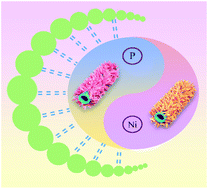Two-in-one template-assisted construction of hollow phosphide nanotubes for electrochemical energy storage†
Abstract
In this work, a template-assisted method was used to develop novel Ni2P@PANI hollow nanotubes as a positive electrode material for supercapacitors using prepared polyaniline (PANI) nanotubes as precursors, and their electrochemical behavior was studied. The results revealed that the Ni2P@PANI nanotube electrode exhibited an average high specific capacity of 866 C g−1 at 2 A g−1. The experimental data were combined with density functional theory (DFT) calculations to reveal that the strong interaction between PANI and Ni2P may lead to the formation of novel bonds at their interface and promote the redistribution of charges within the electrode, improving the capacitive properties. The combination of PANI and Ni2P facilitated the adsorption and desorption of OH−, resulting in a rapid Faraday redox reaction at the electrodes. Additionally, a unique Fe2O3@PNCT hollow nanotube was fabricated as the negative electrode with the same PANI nanotube precursor. Thus, a “two-in-one” strategy was implemented. The assembled quasi-solid-state asymmetric supercapacitor exhibited a high energy density of 60.6 W h kg−1 at a power density of 852.3 W kg−1 and a high-capacity retention rate of 79.8% after 10 000 cycles.

- This article is part of the themed collection: FOCUS: Recent Advance in Supercapacitors


 Please wait while we load your content...
Please wait while we load your content...